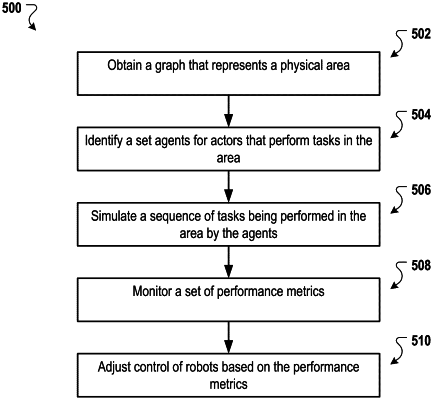| CPC G05D 1/0297 (2013.01) [G05B 13/04 (2013.01); G06F 9/505 (2013.01); B25J 9/1671 (2013.01)] | 21 Claims |

|
1. A computer-implemented method, comprising:
obtaining a graph representing a physical area, the graph comprising (i) a plurality of area nodes that represent regions of the area that are traversed by a set of actors that perform tasks in the area, (ii) a plurality of terminal nodes that represent regions of the facility where the actors perform the tasks, and (iii) edges between the nodes;
identifying a set of agents that each comprise a model corresponding to an actor of the plurality of actors, wherein at least a portion of the agents comprise models for robots that perform tasks in the area, and wherein the model of an agent represents durations of time for traversing area nodes and performing tasks at terminal nodes during simulations;
simulating a sequence of tasks being performed in the area using the graph and the set of agents for the set of actors, wherein simulating the sequence of tasks comprises:
transition an agent from a first node to a second node
determining, based on the model for the agent, a duration of time that the agent will be in the second node
initializing a timer for the agent using the duration of time
causing the agent to remain in the second node until the timer elapses; and
transitioning the agent from the second node to a third node when the time elapses;
monitoring, based on the simulation, a set of performance metrics for performance of the sequence of tasks for the area; and
adjusting control of one or more of the robots based on the performance metrics.
|